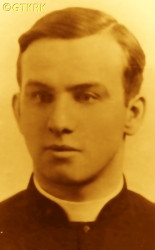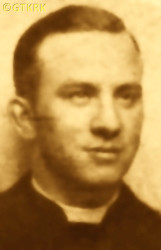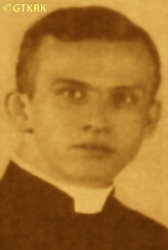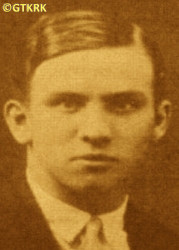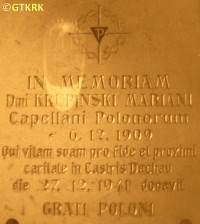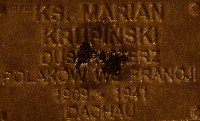Roman Catholic
St Sigismund parish
05-507 Słomczyn
85 Wiślana Str.
Konstancin deanery
Warsaw archdiocese, Poland
full list:
displayClick to display full list

searchClick to search full list by categories
wyświetlKliknij by wyświetlić pełną listę po polsku

szukajKliknij by przeszukać listę wg kategorii po polsku

Martyrology of the clergy — Poland
XX century (1914 – 1989)
personal data
surname
KRUPIŃSKI
forename(s)
Marian Alexander (pl. Marian Aleksander)
function
diocesan priest
creed
Latin (Roman Catholic) Church RCmore on
en.wikipedia.org
[access: 2014.09.21]
diocese / province
Polish Catholic Mission in France
Gniezno and Poznań archdiocese (aeque principaliter)more on
www.archpoznan.pl
[access: 2012.11.23]
date and place
of death
27.12.1941

KL Dachauconcentration camp
today: Dachau, Upper Bavaria reg., Bavaria state, Germany
more on
en.wikipedia.org
[access: 2016.05.30]
details of death
After German and Russian invasion of Poland in 09.1939 and start of the World War II, after start in 05‐06.1940 of German occupation of France, jailed by the Germans prob. on 20.09.1940 in Mühlhausen, in the German–occupied France.
Held in a German security camp Germ. Sicherungslager Schirmeck–Vorbruck n. Strassburg and then transported to KL Dachau concentration camp where was murdered — tortured, admitted to camp's „hospital” and there prob. given a lethal injection.
According to the death certificate, prepared in KL Dachau, the „honest” otherwise German „medical doctors” and formalists — and at the same time, unrivaled fairy tale spinners — noted that the cause of death was Germ. „Versagen von Herz und Kreislauf, bei offener Lungenentzündung” (Eng. „Heart and circulatory failure, due to open pneumonia”).
prisoner camp's numbers
26333Click to display source page (KL DachauClick to display the description)
cause of death
extermination: exhaustion, starvation and lethal injection
perpetrators
Germans
sites and events
KL DachauClick to display the description, Ribbentrop‐MolotovClick to display the description, Pius XI's encyclicalsClick to display the description
date and place
of birth
06.12.1909Birth certification on:
photos.szukajwarchiwach.gov.pl
[access: 2025.09.29]

Koźmintoday: Koźmin Wielkopolski, Koźmin Wielkopolski gm., Krotoszyn pov., Greater Poland voiv., Poland
more on
en.wikipedia.org
[access: 2021.05.20]
parents
KRUPIŃSKI Joseph
🞲 ?, ? — 🕆 ?, ?

KAPUŚCIŃSKA Constance
🞲 ?, ? — 🕆 ?, ?
presbyter (holy orders)
ordination
15.06.1935

Gnieznotoday: Gniezno urban gm., Gniezno pov., Greater Poland voiv., Poland
more on
en.wikipedia.org
[access: 2021.12.18]
Assumption of the Blessed Virgin Mary RC archcathedral churchmore on
en.wikipedia.org
[access: 2025.03.14]
positions held
from 1940
priest — Wittenheimtoday: Mulhouse arr., Haut‐Rhin dep., Grand Est reg., France
more on
en.wikipedia.org
[access: 2022.07.16] — among Polish emigrants and migrants
from 1938
priest — Sallauminestoday: Pas‐de‐Calais dep., Hauts‐de‐France reg., France
more on
en.wikipedia.org
[access: 2023.03.16] — among Polish emigrants and migrants
1937 – 1938
priest — Charleroitoday: Charleroi mun., Hainaut prov., Wallonia reg., Belgium
more on
en.wikipedia.org
[access: 2022.08.05] — among Polish emigrants and migrants in the Charleroi district (including the following colonies: Charleroi, Marcinelle, Chatelineau, Tailli–Pré, Gilli, Cuillet, Tamines, Farciennes, Jumet Houboide, Junut Malavé, Dampremy, Marchine au Pont, Monhan sur Sombre, Fontaine l'Eveque, Anderlues), liturgy celebrated in: Andvilus (for Anderlues, Fontaini–Brîyne and the surrounding area); Marchi–nu–au–Pont (for Marchinne and Mont sur Marchinni, Monuan); Jumit–Malaria (for Jumit, Roux, Ludichsart); Marcinille (for Marcinille, Gouillat, Charlvirs); Chatelineau–Centre (for Chatelineau, Châtilit, Montigny Sambre, part of Gilly); Chatelineau–Tallis–Pri (for the second part with Chatelineau, Gilly, Farcinnus–Veinage, Pirmmchaumps, Rausart, Vieux–Gampiriaire); Farcinnes: (for Farcinnes, Roselies and the surrounding area); Moignelii: (Moignelii, Lambursat, Tamines); La Dochrvie (for Dochrvie and surrounding areas)
1936 – 1937
vicar — Połajewotoday: Połajewo gm., Czarnków/Trzcianka pov., Greater Poland voiv., Poland
more on
en.wikipedia.org
[access: 2021.07.18] ⋄ St Michael the Archangel RC parish ⋄ Czarnkówtoday: Czarnków gm., Czarnków/Trzcianka pov., Greater Poland voiv., Poland
more on
en.wikipedia.org
[access: 2021.06.20] RC deanery
1936
vicar — Piłkatoday: Drawsko gm., Czarnków/Trzcianka pov., Greater Poland voiv., Poland
more on
en.wikipedia.org
[access: 2021.05.20] ⋄ Blessed Virgin Mary of the Assumption RC parish ⋄ Czarnkówtoday: Czarnków gm., Czarnków/Trzcianka pov., Greater Poland voiv., Poland
more on
en.wikipedia.org
[access: 2021.06.20] RC deanery
1935 – 1936
vicar — Miejska Górkatoday: Miejska Górka gm., Rawicz pov., Greater Poland voiv., Poland
more on
en.wikipedia.org
[access: 2021.12.18] ⋄ St Nicholas the Bishop and Confessor RC parish ⋄ Jutrosintoday: Jutrosin gm., Rawicz pov., Greater Poland voiv., Poland
more on
en.wikipedia.org
[access: 2021.12.19] RC deanery
till 1935
student — Gnieznotoday: Gniezno urban gm., Gniezno pov., Greater Poland voiv., Poland
more on
en.wikipedia.org
[access: 2021.12.18] ⋄ philosophy and theology, Archbishop's Theological Seminary
from 1930
student — Poznańtoday: Poznań city pov., Greater Poland voiv., Poland
more on
en.wikipedia.org
[access: 2021.07.18] ⋄ philosophy and theology, Foreign Seminary — on 15.09.1930, signed a commitment to „work for twelve years among Poles abroad”
others related
in death
BYTOŃSKIClick to display biography Felix, DORSZClick to display biography Bruno, FEDOROWICZClick to display biography Ceslav, GIELECClick to display biography Vladislav Emil, GRZĄDKAClick to display biography Hippolytus, KAŁASClick to display biography Edmund, KRZYSZKOWSKIClick to display biography Ceslav, MAKIELAClick to display biography Theodore Francis, ROGACZEWSKIClick to display biography Adalbert Theophilus, SIBILSKIClick to display biography Julian, WARTAŁOWICZClick to display biography Alexander (Fr Boleslav)
sites and events
descriptions
KL Dachau: KL Dachau in German Bavaria, set up in 1933, became the main German Germ. Konzentrationslager (Eng. concentration camp) KL for Catholic priests and religious during World War II: On c. 09.11.1940, Reichsführer‐SS Heinrich Himmler, head of the SS, Gestapo and German police, as a result of the Vatican's intervention, decided to transfer all clergymen detained in various concentration camps to KL Dachau camp. The first major transports took place on 08.12.1940. In KL Dachau Germans held approx. 3,000 priests, including 1,800 Poles. The priests were forced to slave labor in the Germ. „Die Plantage” — the largest herb garden in Europe, managed by the genocidal SS, consisting of many greenhouses, laboratory buildings and arable land, where experiments with new natural medicines were conducted — for many hours, without breaks, without protective clothing, no food. They slaved in construction, e.g. of camp's crematorium. In the barracks ruled hunger, freezing cold in the winter and suffocating heat during the summer, especially acute in 1941‐1942. Prisoners suffered from bouts of illnesses, including tuberculosis. Many were victims of murderous „medical experiments” — in 11.1942 c. 20 were given phlegmon injections; in 07.1942 to 05.1944 c. 120 were used by for malaria experiments. More than 750 Polish clerics where murdered by the Germans, some brought to TA Hartheim euthanasia centre set up in Schloss Hartheim in Austria and murdered in gas chambers. At its peak KL Dachau concentration camps’ system had nearly 100 slave labour sub‐camps located throughout southern Germany and Austria. There were c. 32,000 documented deaths at the camp, and thousands perished without a trace. C. 10,000 of the 30,000 inmates were found sick at the time of liberation, on 29.04.1945, by the USA troops… (more on: www.kz-gedenkstaette-dachau.deClick to attempt to display webpage
[access: 2013.08.10], en.wikipedia.orgClick to attempt to display webpage
[access: 2016.05.30])
Ribbentrop‐Molotov: Genocidal Russian‐German alliance pact between Russian leader Joseph Stalin and German leader Adolf Hitler signed on 23.08.1939 in Moscow by respective foreign ministers, Mr. Vyacheslav Molotov for Russia and Joachim von Ribbentrop for Germany. The pact sanctioned and was the direct cause of joint Russian and German invasion of Poland and the outbreak of the World War II in 09.1939. In a political sense, the pact was an attempt to restore the status quo ante before 1914, with one exception, namely the „commercial” exchange of the so‐called „Kingdom of Poland”, which in 1914 was part of the Russian Empire, fore Eastern Galicia (today's western Ukraine), in 1914 belonging to the Austro‐Hungarian Empire. Galicia, including Lviv, was to be taken over by the Russians, the „Kingdom of Poland” — under the name of the General Governorate — Germany. The resultant „war was one of the greatest calamities and dramas of humanity in history, for two atheistic and anti‐Christian ideologies — national and international socialism — rejected God and His fifth Decalogue commandment: Thou shall not kill!” (Abp Stanislav Gądecki, 01.09.2019). The decisions taken — backed up by the betrayal of the formal allies of Poland, France and Germany, which on 12.09.1939, at a joint conference in Abbeville, decided not to provide aid to attacked Poland and not to take military action against Germany (a clear breach of treaty obligations with Poland) — were on 28.09.1939 slightly altered and made more precise when a treaty on „German‐Russian boundaries and friendship” was agreed by the same murderous signatories. One of its findings was establishment of spheres of influence in Central and Eastern Europe and in consequence IV partition of Poland. In one of its secret annexes agreed, that: „the Signatories will not tolerate on its respective territories any Polish propaganda that affects the territory of the other Side. On their respective territories they will suppress all such propaganda and inform each other of the measures taken to accomplish it”. The agreements resulted in a series of meeting between two genocidal organization representing both sides — German Gestapo and Russian NKVD when coordination of efforts to exterminate Polish intelligentsia and Polish leading classes (in Germany called «Intelligenzaktion», in Russia took the form of Katyń massacres) where discussed. Resulted in deaths of hundreds of thousands of Polish intelligentsia, including thousands of priests presented here, and tens of millions of ordinary people,. The results of this Russian‐German pact lasted till 1989 and are still in evidence even today. (more on: en.wikipedia.orgClick to attempt to display webpage
[access: 2015.09.30])
Pius XI's encyclicals: Facing the creation of two totalitarian systems in Europe, which seemed to compete with each other, though there were more similarities than contradictions between them, Pope Pius XI issued in 03.1937 (within 5 days) two encyclicals. In the „Mit brennender Sorge” (Eng. „With Burning Concern”) published on 14.03.1938, condemned the national socialism prevailing in Germany. The Pope wrote: „Whoever, following the old Germanic‐pre‐Christian beliefs, puts various impersonal fate in the place of a personal God, denies the wisdom of God and Providence […], whoever exalts earthly values: race or nation, or state, or state system, representatives of state power or other fundamental values of human society, […] and makes them the highest standard of all values, including religious ones, and idolizes them, this one […] is far from true faith in God and from a worldview corresponding to such faith”. On 19.03.1937, published „Divini Redemptoris” (Eng. „Divine Redeemer”), in which criticized Russian communism, dialectical materialism and the class struggle theory. The Pope wrote: „Communism deprives man of freedom, and therefore the spiritual basis of all life norms. It deprives the human person of all his dignity and any moral support with which he could resist the onslaught of blind passions […] This is the new gospel that Bolshevik and godless communism preaches as a message of salvation and redemption of humanity”… Pius XI demanded that the established human law be subjected to the natural law of God , recommended the implementation of the ideal of a Christian state and society, and called on Catholics to resist. Two years later, National Socialist Germany and Communist Russia came together and started World War II. (more on: www.vatican.vaClick to attempt to display webpage
[access: 2023.05.28], www.vatican.vaClick to attempt to display webpage
[access: 2023.05.28])
sources
personal:
www.wtg-gniazdo.orgClick to attempt to display webpage
[access: 2012.11.23], cdn.website-editor.netClick to attempt to display webpage
[access: 2020.09.18], photos.szukajwarchiwach.gov.plClick to attempt to display webpage
[access: 2025.09.29], www.ipgs.usClick to attempt to display webpage
[access: 2012.11.23]
bibliographical:
„Martyrology of the Polish Roman Catholic clergy under nazi occupation in 1939‐1945”, Victor Jacewicz, John Woś, vol. I‐V, Warsaw Theological Academy, 1977‐1981
„Pastors of the Polish Diaspora and Poles Abroad — Biographical Dictionary”, Fr Joseph Szymański, vol. II, Lublin 2011
„International Tracing Service (ITS), Bad Arolsen, GermanyClick to display source page”, Arolsen Archives
original images:
cdn.website-editor.netClick to attempt to display webpage
[access: 2020.09.18], cdn.website-editor.netClick to attempt to display webpage
[access: 2020.09.18], cdn.website-editor.netClick to attempt to display webpage
[access: 2020.09.18], cdn.website-editor.netClick to attempt to display webpage
[access: 2020.09.18], cdn.website-editor.netClick to attempt to display webpage
[access: 2020.09.18]
LETTER to CUSTODIAN/ADMINISTRATOR
If you have an Email client on your communicator/computer — such as Mozilla Thunderbird, Windows Mail or Microsoft Outlook, described at WikipediaPatrz:
en.wikipedia.org, among others — try the link below, please:
LETTER to CUSTODIAN/ADMINISTRATORClick and try to call your own Email client
If however you do not run such a client or the above link is not active please send an email to the Custodian/Administrator using your account — in your customary email/correspondence engine — at the following address:

giving the following as the subject:
MARTYROLOGY: KRUPIŃSKI Marian Alexander
To return to the biography press below:
 Click to return to biography
Click to return to biography








